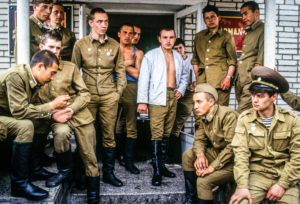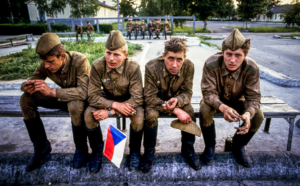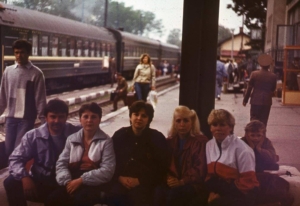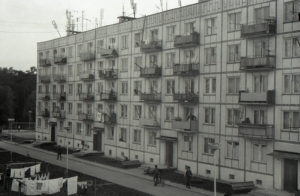Life in a soviet garrison
1968 – 1991

Soviet soldiers during a rare moment of rest.
Soviet soldiers spent 18 to 21 months of their two-year full-time service in the Czechoslovakia. They could leave the gates of the barracks only due to duty reasons. They did not receive passes in Czechoslovakia. The officers kept the men constantly on the move, busy, and therefore under control. The soldiers had to devote all their personal time off to maintaining their equipment. An integral part of the training was also the effort to indoctrinate the soldiers with communist propaganda.

Czechoslovak citizens that came into contact with the soviet soldiers described them as always hungry, dirty, nervous young boys.
During their first year of service in the Soviet Army, recruits were subjected to bullying from older soldiers, known as “dědovščina”. Usually, the ghost (pheasant) had to clean the fields and do other unpleasant work instead of the grandfather (the cleaner). But the bullying often degenerated into psychological terror and brutal violence. Some soldiers were bullied into desertion. It is estimated that dozens of soldiers deserted from the Soviet garrisons in Czechoslovakia every year. Their number increased after the Velvet Revolution, when they tried to obtain political asylum.

Officers debating at the Balonka housing estate. A bicycle was one of their main forms of transports.
Professional soldiers served in the Central Group of Soviet troops for 3 to 5 years. Officers‘ wives were either housewives or employed by the army. Their children attended Soviet schools in large garrisons. In Milovice, soldiers lived in the Balonka housing estate, and in the 1970s, the Mladá and Boží Dar housing estates were built for them. Often, two families had to share one apartment. Professional soldiers and civilians could move freely even outside of the garrison area.

A routine train Moscow – Milovice and back crossed the borders of the Czechoslovak Socialist Republic as part of the Slovak express.
There was a routine train between Moscow and Milovice, that carried only soviet passengers. Together with the passengers, shortage goods were also flowing both ways, that was carefully packed into envelope-like folded rugs, as to deter any customs officers. Krystal, chewing gum and footwear was among the most common goods flowing into the Soviet union. Meanwhile the goods flowing the most to Czechoslovakia were colourful TV’s, vacuum cleaners and cameras. Enterprising individuals were able to improve their financial situation in a short time and purchased an older vehicle in the Czechoslovak Socialist Republic.

The biggest dream of every Soviet officer was to buy his own car of the brand Volga.
Did you know that…? Since 1968, the newspaper of the Central Group of Soviet Troops „Советский солдат“ (Soviet Soldier) has been published in Milovice.

The so-called “Kyjeváky” (Kyivan houses) in the Boží Dar housing estate.
